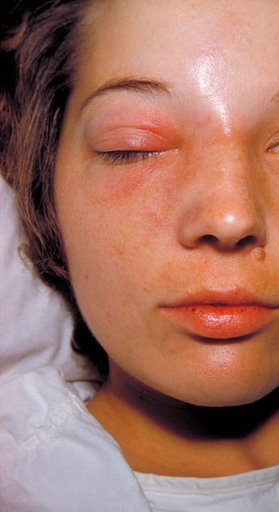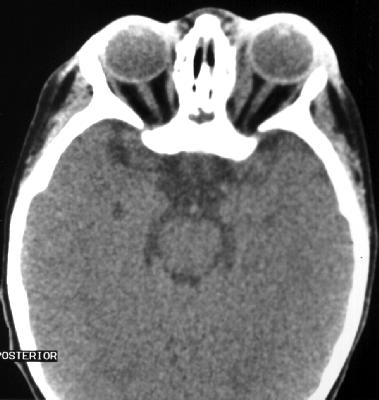Orbital cellulitis
For patient information, click here
Editor-In-Chief: C. Michael Gibson, M.S., M.D. [1] Associate Editor(s)-In-Chief: Prashanth Saddala M.B.B.S
|
Orbital cellulitis Microchapters |
|
Diagnosis |
|---|
|
Treatment |
|
Case Studies |
|
Orbital cellulitis On the Web |
|
American Roentgen Ray Society Images of Orbital cellulitis |
Overview
Orbital cellulitis is a serious infection of the orbital tissues which can lead to restriction of eye movements, loss of vision and even loss of life. Orbital cellulitis is an inflammation of eye tissues posterior to the orbital septum. It most commonly refers to an acute spread of infection into the eye socket from either the adjacent sinuses or through the blood. When it affects the rear of the eye, it is known as retro-orbital cellulitis.
It should not be confused with periorbital cellulitis, which refers to cellulitis anterior to the septum.
Causes
Orbital cellulitis occurs commonly from bacterial infection spread by the paranasal sinuses. Other ways in which orbital cellulitis may occur is from infection in the blood stream and from an eyelid skin infection. Upper respiratory infection, sinusitis, trauma to the eye, ocular or periocular infection and systemic infection all increase one’s risk of orbital cellulitis.
Staphylococcus aureus, Streptococcus pneumoniae and beta-hemolytic streptococci are three bacteria that can be responsible for orbital cellulitis.
- Staphylococcus aureus, is a gram-positive bacterium which is the most common of staph infections. Staphylococcus aureus infection can spread to the orbit from the skin. Staph organisms are able to produce toxins which promote their virulence which leads to the inflammatory response seen in orbital cellulitis. Staphylococcus infections are identified by a cluster arrangement on gram stain. Staphylococcus aureus forms large yellow colonies (which is distinct from other Staph infections such as Staphylococcus epidermis which forms white colonies).
- Streptococcus pneumoniae, is also a gram-positive bacterium responsible for orbital cellulitis due to its ability to infect the sinuses (sinusitis). Strep organisms are able to determine their own virulence and can invade surrounding tissues causing an inflammatory response seen in orbital cellulitis (similar to Staphyloccoccus aureus). Streptococcal infections are identified on culture by their formation of pairs or chains. Streptococcus pneumoniae produce green (alpha) hemolysis, or partial reduction of red blood cell hemoglobin.
Diagnosis
Orbital cellulitis should be differentiated from preseptal cellulitis which is confined to structures anterior to orbital septum. Where as, orbital cellulitis involves structures posterior to orbital septum which includes fat and ocular muscles.
History and Symptoms
Patients present with sudden onset of fever, proptosis, restricted eye movement, and swelling and redness of the eye lids. It is usually caused by a previous sinusitis. Patients commonly complain of pain when moving the eye, sudden loss of vision, bulging of the eye or eyes that are infected and limited eye movement. Along with these symptoms, patients typically have redness and swelling of the eyelid, pain, discharge, inability to open the eye, occasional fever and lethargy. It is usually caused by a previous sinusitis. Other causes include infection of nearby structures, trauma and previous surgery.
Physical Examination
Eyes

MRI and CT

N, C and P
The feared complications include cavernous sinus thrombosis and meningitis. Abscess formation is another complication and may require surgical drainage.
Complications include hearing loss, blood infection, meningitis, and optic nerve damage (which could lead to blindness).
Although orbital cellulitis is considered an ophthalmic emergency the prognosis is good if prompt medical treatment is received.
Death and blindness rates without treatment
Bacterial infections of the orbit have long been associated with a risk of catastrophic local sequelae and intracranial spread.
The natural course of the disease, as documented by Gamble (1933), in the pre-antibiotic era, resulted in death in 17% of patients and permanent blindness in 20%.
Treatment
Because of concern for spread of infection, patients must be admitted to the hospital to receive intravenous antibiotics. Orbital cellulitis is considered an ophthalmological emergency.
Prompt treatment is vital for a patient when fighting orbital cellulitis. Treatment typically involves IV antibiotics in the hospital and frequent observation (every 4-6 hours). Along with this several laboratory tests are run including a complete blood count, differential, and blood culture.
- Antibiotic Therapy - Since orbital cellulitis is commonly caused by Staphylococcus and Streptococcus species both penicillins and cephalosporins are typically the best choices for IV antibiotics. However, due to the increasing rise of MRSA (methicillin-resistant Staphylococcus aureus) orbital cellulitis can also be treated with Vancomycin, Clindamycin, or Doxycycline. If improvement is noted after 48 hours of IV antibiotics, healthcare professions can then consider switching a patient to oral antibiotics (which must be used for 2-3 weeks).
- Surgical Intervention - An abscess can threaten the vision or neurological status of a patient with orbital cellulitis, therefore sometimes surgical intervention is necessary. Surgery typically requires drainage of the sinuses and if a subperiosteal abscess is present in the medial orbit, drainage can be performed endoscopically. Post-operatively, patients must follow up regularly with their surgeon and remain under close observation.